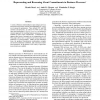37 search results - page 3 / 8 » Reasoning about the Behavior of Semantic Web Services with C... |
AAAI
2007
13 years 7 months ago
2007
A variety of business relationships in open settings can be understood in terms of the creation and manipulation of commitments among the participants. These include B2C and B2B c...
ICDE
2008
IEEE
13 years 12 months ago
2008
IEEE
Recent years have seen a proliferation of work on the Semantic Web, an initiative to enable intelligent agents to reason about and utilize World Wide Web content and services. Con...
IS
2006
13 years 5 months ago
2006
This paper introduces a method for automatic composition of Semantic Web services using Linear Logic (LL) theorem proving. The method uses a Semantic Web service language (DAML-S)...
JCS
1998
13 years 5 months ago
1998
Multilevel transactions have been proposed for multilevel secure databases; in contrast to most proposals, such transactions allow users to read and write across multiple security...
ESOP
2010
Springer
14 years 2 months ago
2010
Springer
Formal reasoning about concurrent programs is usually done with the assumption that the underlying memory model is sequentially consistent, i.e. the execution outcome is equivalen...


